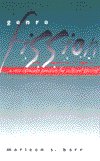Genre Fission
“Our times astonish us because pop culture confuses wildly diverse cultural events of gender, race, and class. By herself mixing incongruous events, Marleen Barr develops a critical discourse for talking about, precisely, gender, race, and class. And she does it in such a lively, witty style you'd never dream you're reading heavy-duty cultural theory.”—Norman N. Holland, University of Florida
“Marleen S. Barr's latest breakthrough book invents nothing less than a new theory of reading, one appropriate to an era in which genres just won't stay still. Tackling prose fiction, theory, film, television, painting, and much else—and written in a lively, engaging, deliberately irreverent style—Genre Fission is an indispensable contribution to modern cultural studies.”—Carl Freedman, author of Critical Theory and Science Fiction
What do Amsterdam prostitutes, NASA astronauts, cross-dressing texts, and Star Trek characters have in common? Only Marleen Barr knows for sure. In Genre Fission, the award-winning author revitalizes literary and cultural theory by proposing an entirely new discourse practice of examining the points where genres and attendant meanings first converge, then reemerge as something new. Part literary analysis, part cultural studies, part feminist critique flavored with a smattering of science fiction and utopian studies, it is witty and eccentric, entertaining and enlightening.
Barr expands postmodern assumptions about cultural studies by suggesting that "genre fission" is occurring among discrete literary and cultural "types" of events—mainstream novels, science fiction, historical narratives, film, paintings, and museum displays. For her literary insights, Barr turns her attention to such mainstream authors as Saul Bellow, John Updike, Marge Piercy, and John Barth as well as science fiction writers Ursula Le Guin and Octavia Butler and Hispanic American writers Julia Alvarez, Ana Castillo, and Cristina García, among others.
Barr moves from literary to culture studies by addressing such phenomena from contemporary mass culture as the urban landscapes of New York and Los Angeles, Jackie Kennedy, the Star Trek industry, Lynn Redgrave, Amsterdam's red light district, Lorena Bobbitt, and the Apollo astronauts—to provide only a few of the relevant examples. Thus Genre Fission attains what Barr herself designates (in describing the art of Judy Chicago and Lee Bontecou) as "utopian interweavings of difference," crossing numerous boundaries in order to frame a larger territory for exploration.
Introduction: "The Grand Mix" or Who Wears the White Hats When the Barbie Liberation Organization Strikes Back?
I. Private Lives: Peaceful Coexistences
1. Bridging the Dead Father's Canonical Divide: Max Apple, Saul Bellow, Edgar Allan Poe, and Lynn Redgrave Form a Textual Cross-Dresser Support Group
2. "All Good Things": The End of Star Trek: The Next Generation, the End of Camelot, and the End of the Tale about Woman as Handmaid to Patriarchy-as-Superman
3. Shutting the Bestial Mouth: Confessions of Male Clones and Girl Gangs
II. Public Displays: Sexed Spectacles
4. Night Watch in Amsterdam's Red Light District: Prostitutes/Dutch Windows/Utopian and Dystopian Gazes
5. Los York/ New Angeles: "New York, New York, a Helluva Town" Sings " I Wish They All Could Be California Girls"
6. American Middle-Class Males Mark the Moon: Retrospectively Reading the Apollo Program of Lorena Bobbitt vs. the Saturn 5
III. Premier Discourses: First Times
7. Women "Churtening" via the Cha Cha: Ursula K. LeGuin and Hispanic-American Auhors Write to the Same Rhythm
8. Wrapping the Reichstag vs. Rapping Racism or "A Colored Kind of White People": Black/ White/ Jew/ Gentile
9. Playing with Time: The Holocaust as "A Different Universe of Discours"
Epilogue: Discourse as Black Hole- and as Liberated Light
Notes
Work Cited
Index



